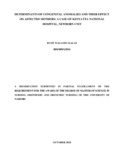| dc.contributor.author | Kalae, Ruth W | |
| dc.date.accessioned | 2019-01-22T08:05:57Z | |
| dc.date.available | 2019-01-22T08:05:57Z | |
| dc.date.issued | 2018 | |
| dc.identifier.uri | http://hdl.handle.net/11295/105231 | |
| dc.description.abstract | Background: Congenital anomalies are defects of structure, function or metabolism that are present at birth. It is estimated that 3-7% of children worldwide are born with congenital anomalies. With advanced medical and neonatal care, infant mortality related to sepsis, respiratory diseases and asphyxia has steadily declined. This makes congenital anomalies an important cause of neonatal mortality. Despite this information, limited studies have been done in Kenya to establish determinants of congenital anomalies and their effect on affected mothers
Study objective: The objective of this study was to describe the determinants of congenital anomalies and their effect on affected mothers.
Methodology: This was a hospital based descriptive, cross-sectional study design; which utilized both qualitative and quantitative approaches. 55 respondents were recruited for this study; 52 neonates (Fishers formula) and 3 Key Informants. Some of the 52 were recruited for In-depth interviews (data saturation method). A researcher-administered questionnaire and an interview guide were used to collect data. Data from structured questionnaires was entered, checked, cleaned and analyzed using SPSS version 20. Descriptive analysis using means, frequency and proportions was computed. Qualitative data was analyzed thematically using N-Vivo software.
Results: Analysis of the data showed that among the 315 neonates admitted in NBU, KNH, the prevalence of Congenital Anomalies (CAs) was 19.4%. The Musculoskeletal system was the most affected (38.5%). 88.4% of the mothers were below 35years of age and 61.5% were not working. The prevalence of CAs was more among neonates born vaginally. Four themes were narrated: Knowledge, Reaction, Support from social environment and support from heath care system.
Conclusion: KNH and MOH should mobilize more resources to combat this burden because of the high prevalence of birth defects recorded. The public should be educated on risk factors of CAs. Social and psychological support should be offered to affected mothers. | en_US |
| dc.language.iso | en | en_US |
| dc.publisher | University of Nairobi | en_US |
| dc.rights | Attribution-NonCommercial-NoDerivs 3.0 United States | * |
| dc.rights.uri | http://creativecommons.org/licenses/by-nc-nd/3.0/us/ | * |
| dc.title | Determinants of Congenital Anomalies and Their Effect on Affected Mothers: a Case of Kenyatta National Hospital, Newborn Unit | en_US |
| dc.type | Thesis | en_US |
| dc.description.department | a
Department of Psychiatry, University of Nairobi, ; bDepartment of Mental Health, School of Medicine,
Moi University, Eldoret, Kenya | |



